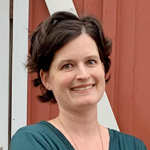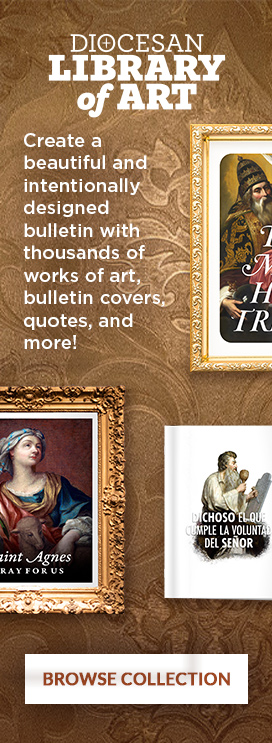We learn sequencing and the order of rituals at a very early age. Infants are able to anticipate “what comes next” in basic sequences of events that have been routinely incorporated into their daily life. For example, a bedtime routine might consist of a diaper change, pajamas, short picture book, feeding in a dark room, and background white noise or soft music only used at bedtime. The end result (the parents desperately hope), is a sleepy baby who is ready to rest for more than 2 hours. This, of course, takes time, patience, and practice. However, study after study shows that a solid, consistent, unvarying routine will eventually result in a baby who somewhat regularly goes to sleep.
Rituals and routines continue throughout our lives. There is a certain order of things in our daily existence: morning routines, after school routines, even our own bedtime routines. Each one cues our minds and bodies to a certain time of day or series of events that comes next.
In our Gospel today, Jesus offers us a routine, a blueprint, for how to consistently follow God and find Him in each moment. In order for the routine to work, however, the order must be followed as Jesus gave it to us.
First, and foremost, we must love God. Jesus quotes Deuteronomy 6:4-5. This is the Shema, the great commandment of the Lord. Before all else and above all else and with our whole self, we must love God.
Love is not a static thing. It is active, vibrant, and multiplicative. Each time love is given, more love returns and expands. Therefore, it is logical that if we give God our love, love will be given back to us in equal and even fuller measure. What we receive, we can then continue to give. We give the love back to God, continuing the cycle of loving, but we have received even more than we gave. Where does the overflow of love go?
Jesus tells us it goes to two places. First, we must love ourselves. We are God’s beloved sons and daughters. We are made in His image and each of us is precious and unique. When we love ourselves with the love God has for us, we will recognize our inherent dignity and worth in His eyes.
Our cup continues to overflow, because now that we have loved God and loved ourselves, we are bursting with a love that keeps multiplying. Who else can we share this love with? Our neighbor. When we share love with our neighbor, we are not only sharing love with him or her, but we are also loving Jesus who lives within them.
The great cycle of love continues. Love of God, love and affirmation of self in the eyes of God, love of each of God’s children in whom God dwells. The deeper we enter into this cycle of love, the greater our capacity to love will grow.
Aprendemos la secuencia y el orden de las costumbres a una edad muy temprana. Los bebés son capaces de anticipar “lo que viene después” en secuencias básicas de acontecimientos que se han incorporado de forma rutinaria a su vida diaria. Por ejemplo, una rutina a la hora de acostarse puede consistir en cambiar pañales, poner los pijamas, leer un libro ilustrado breve, alimentarlo en una habitación oscura y poner ruido blanco de fondo o música suave que solo se utiliza antes de acostarse. El resultado final (los padres esperan desesperadamente) es un bebé somnoliento que está listo para descansar por más de 2 horas. Esto, por supuesto, requiere tiempo, paciencia y práctica. Sin embargo, estudio tras estudio muestra que una rutina sólida, consistente e invariable eventualmente dará como resultado un bebé que duerme con cierta regularidad.
Las costumbres y rutinas continúan a lo largo de la vida. Hay un cierto orden en la existencia diaria: las rutinas matutinas, las rutinas después de la escuela, incluso nuestras propias rutinas a la hora de dormir. Cada uno indica a nuestras mentes y cuerpos una determinada hora del día o una serie de eventos que vienen a continuación.
En nuestro Evangelio de hoy, Jesús nos ofrece una rutina, un modelo, sobre cómo seguir constantemente a Dios y encontrarlo en cada momento. Sin embargo, para que la rutina funcione, se debe seguir el orden tal como Jesús nos lo dio. Primero y más importante, debemos amar a Dios. Jesús cita Deuteronomio 6:4-5. Este es el Shemá, el gran mandamiento del Señor. Ante todo y sobre todo y con todo nuestro ser, debemos amar a Dios.
El amor no es algo estático. Es activo, vibrante y multiplicativo. Cada vez que se entrega el amor, más amor regresa y se expande. Por tanto, es lógico que si damos a Dios nuestro amor, el amor nos será devuelto en igual y aún mayor medida. Lo que recibimos, lo podemos seguir dando. Devolvemos el amor a Dios, continuando el ciclo de amar, pero hemos recibido incluso más de lo que dimos. ¿A dónde va el desbordamiento del amor?
Jesús nos dice que va a dos lugares. Primero, debemos amarnos a nosotros mismos. Somos los hijos e hijas amados de Dios. Estamos hechos a Su imagen y cada uno de nosotros es precioso y único. Cuando nos amamos a nosotros mismos con el amor que Dios tiene por nosotros, reconoceremos nuestra dignidad y valor inherentes ante sus ojos.
Nuestra copa sigue rebosando, porque ahora que hemos amado a Dios y nos hemos amado a nosotros mismos, estamos rebosantes de un amor que se sigue multiplicando. ¿Con quién más podemos compartir este amor? Nuestro vecino. Cuando compartimos amor con nuestro prójimo, no sólo estamos compartiendo amor con él o ella, sino que también estamos amando a Jesús que vive dentro de ellos.
El gran ciclo del amor continúa. Amor de Dios, amor y afirmación de uno mismo ante los ojos de Dios, amor de cada uno de los hijos de Dios en quienes Dios habita. Cuanto más profundamente entremos en este ciclo de amor, mayor crecerá nuestra capacidad de amar.
 Kate Taliaferro is an Air Force wife and mother. She is blessed to be able to homeschool, bake bread and fold endless piles of laundry. When not planning a school day, writing a blog post or cooking pasta, Kate can be found curled up with a book or working with some kind of fiber craft. Kate blogs at DailyGraces.net.
Kate Taliaferro is an Air Force wife and mother. She is blessed to be able to homeschool, bake bread and fold endless piles of laundry. When not planning a school day, writing a blog post or cooking pasta, Kate can be found curled up with a book or working with some kind of fiber craft. Kate blogs at DailyGraces.net.
Feature Image Credit: Pixabay, www.pexels.com/photo/seashore-269583/
